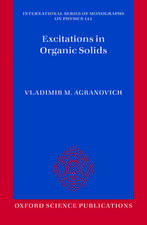Nanobiomaterials in Soft Tissue Engineering: Applications of Nanobiomaterials
Editat de Alexandru Grumezescuen Limba Engleză Hardback – 17 mar 2016
This book covers the major conventional and unconventional fabrication methods of typical three-dimensional scaffolds used in regenerative medicine. Surface modification and spatial properties are included in an up-to-date overview, with the latest in vivo applications of engineered 3D scaffolds discussed. The book also considers the impact, advantages and future scope of the various methods.
This book will be of interest to postdoctoral researchers, professors and students engaged in the fields of materials science, biotechnology and applied chemistry. It will also be highly valuable to those working in industry, including pharmaceutics and biotechnology companies, medical researchers, biomedical engineers and advanced clinicians.
- An informative handbook for researchers, practitioners and students working in biomedical, biotechnological and engineering fields.
- A detailed and invaluable overview of soft tissue engineering, including the most recent scientific developments.
- Proposes novel opportunities and ideas for developing or improving technologies in nanomedicine and nanobiology.
Preț: 835.51 lei
Preț vechi: 1038.33 lei
-20% Nou
Puncte Express: 1253
Preț estimativ în valută:
159.90€ • 166.32$ • 132.00£
159.90€ • 166.32$ • 132.00£
Carte tipărită la comandă
Livrare economică 05-19 aprilie
Preluare comenzi: 021 569.72.76
Specificații
ISBN-13: 9780323428651
ISBN-10: 0323428657
Pagini: 528
Dimensiuni: 191 x 235 x 30 mm
Greutate: 1.3 kg
Editura: ELSEVIER SCIENCE
ISBN-10: 0323428657
Pagini: 528
Dimensiuni: 191 x 235 x 30 mm
Greutate: 1.3 kg
Editura: ELSEVIER SCIENCE
Public țintă
Academic: Materials science, biotechnology and applied chemistry professors, PhD, MsC, postdocs, upper level undergraduate students.Industry: Pharmaceutics and biotechnology companies, medical researchers, biomedical engineers, advanced clinicians.
Cuprins
Chapter 1. Soft tissue engineering and microbial infections: Challenges and perspectives
Chapter 2. Nanotechnology approaches for skin wound regeneration using drug-delivery systems
Chapter 3. Bacterial cellulose for advanced medical materials
Chapter 4. Applications of nanobiopolymers for soft tissue engineering
Chapter 5. Machine design for multimaterial processing
Chapter 6. Advanced nanobiomaterials in tissue engineering: Synthesis, properties, and applications
Chapter 7. Collagen-based nanobiomaterials: Challenges in soft tissue engineering
Chapter 8. Micro/nanofiber-based scaffolds for soft tissue engineering applications: Potential and current challenges
Chapter 9. Natural polymer-based hydrogels as scaffolds for tissue engineering
Chapter 10. Bioactive nanomaterials for cartilage and muscle regeneration
Chapter 11. Fabrication of complex biomaterial scaffolds for soft tissue engineering by electrospinning
Chapter 12. Oxygen-generating nanobiomaterials for the treatment of diabetes: A tissue engineering approach
Chapter 13. Advances in the field of soft tissue engineering: From pure regenerative to integrative solutions
Chapter 14. Tissue engineering: Use of electrospinning technique for recreating physiological functions
Chapter 15. In vivo microscopic and mechanical characteristics of bioengineered and biodegradable tissue scaffolds and nanomaterials
Chapter 2. Nanotechnology approaches for skin wound regeneration using drug-delivery systems
Chapter 3. Bacterial cellulose for advanced medical materials
Chapter 4. Applications of nanobiopolymers for soft tissue engineering
Chapter 5. Machine design for multimaterial processing
Chapter 6. Advanced nanobiomaterials in tissue engineering: Synthesis, properties, and applications
Chapter 7. Collagen-based nanobiomaterials: Challenges in soft tissue engineering
Chapter 8. Micro/nanofiber-based scaffolds for soft tissue engineering applications: Potential and current challenges
Chapter 9. Natural polymer-based hydrogels as scaffolds for tissue engineering
Chapter 10. Bioactive nanomaterials for cartilage and muscle regeneration
Chapter 11. Fabrication of complex biomaterial scaffolds for soft tissue engineering by electrospinning
Chapter 12. Oxygen-generating nanobiomaterials for the treatment of diabetes: A tissue engineering approach
Chapter 13. Advances in the field of soft tissue engineering: From pure regenerative to integrative solutions
Chapter 14. Tissue engineering: Use of electrospinning technique for recreating physiological functions
Chapter 15. In vivo microscopic and mechanical characteristics of bioengineered and biodegradable tissue scaffolds and nanomaterials






















